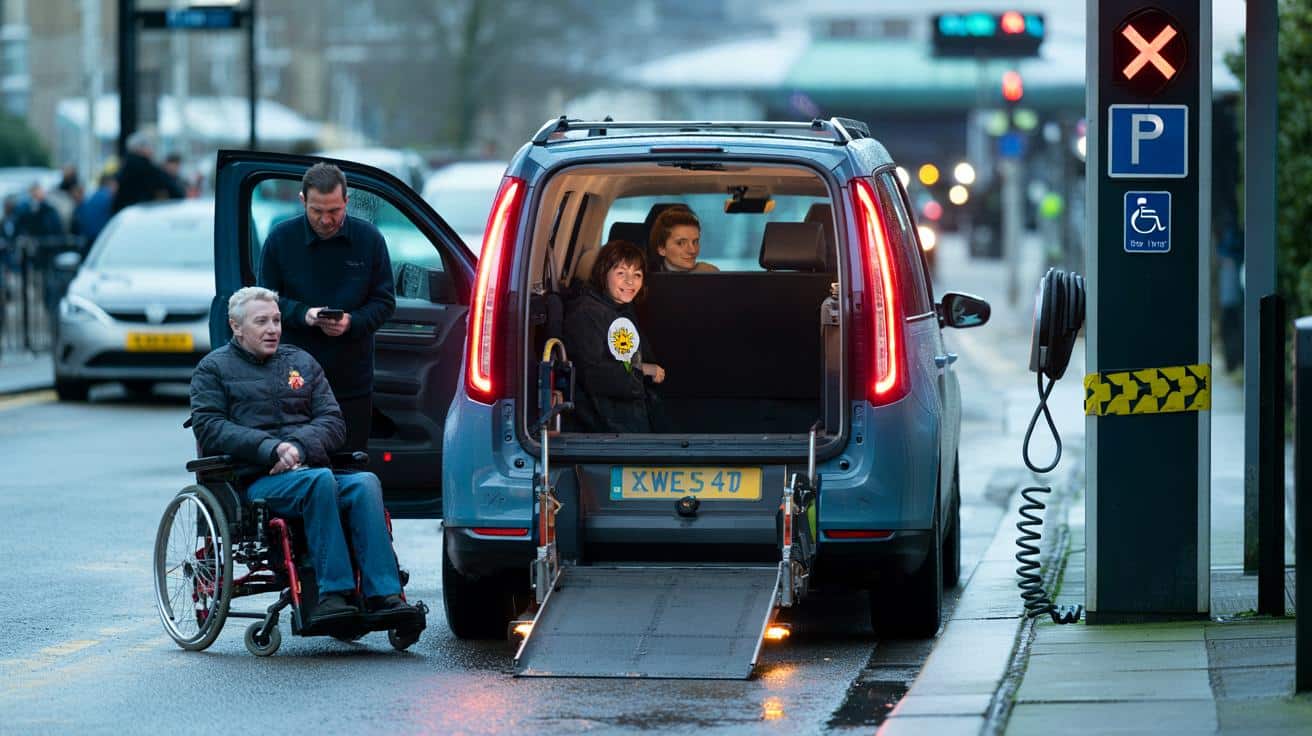It’s the school run, the hospital visit, the quiet pub lunch where the world feels equal for an hour. Talk of cuts turns that everyday freedom into a question mark.
The lift at the station was out again, so the queue at the taxi rank grew longer and tighter, white breath hanging in the air. A blue Motability badge flickered on a windscreen and a driver lowered a portable ramp with the kind of practised care you only learn by living it. A teenager laughed at a joke from the car stereo. A carer checked appointment times on their phone. The scene didn’t shout about policy; it whispered about time, dignity, and how bodies and budgets meet on a cold weekday afternoon. *You notice what matters when it’s harder to reach.* A rumour, a spreadsheet, and a life can collide.
What “cuts” could actually mean
People hear “cuts” and picture a headline, not a doorstep. In practice, it could mean fewer car models on the scheme, higher advance payments, or less help with adaptations like hoists and hand controls. It might look like shorter insurance cover for young named drivers, or a tighter mileage cap on leases.
For some, the cut happens earlier, at the benefit stage. Motability eligibility flows from the higher mobility rate of DLA, the enhanced mobility rate of PIP, or War Pension at mobility level. If assessments toughen or awards shorten, renewals get shaky. Around 700,000 people use Motability in the UK; shift the rules by a notch and thousands feel it in their diary and bank account the very next month.
Then there’s the market itself. Car prices have climbed, insurance has surged, and supply of Wheelchair Accessible Vehicles (WAVs) is stretched. A scheme can hold the line only so long before reality leaks in. So a “cut” might be a choice taken inside Motability, or a push from the outside world. Either way, the impact lands in quiet, ordinary places: parking bays, pharmacy counters, sports halls on a wet Saturday.
The lived ripple, from kerb to kitchen
Picture Maria in Leeds. She uses a powered chair and leases a WAV through the scheme. Her current vehicle took nine months to arrive; the advance payment was already higher than her last. If grants shrink or the model list narrows, the next order becomes a gamble. Does she pick a smaller van that her chair barely fits? Or a bigger one she can’t afford up front? Each option has a cost measured in minutes of care and missed physio slots.
We’ve all had that moment when a small crack becomes a problem you can’t ignore. In rural areas, a driver losing their car often means losing paid work, because the bus runs twice a day and not at the right time. In cities, a taxi that doesn’t take chairs can turn an on-time clinic visit into a no-show. One missed appointment can set a recovery back weeks. None of this shows on a balance sheet until it does—via A&E attendances, cramped housing moves, or carers burning out.
Analysts talk about substitution effects: if one service shrinks, people lean on another. With Motability, the substitutes are messy. Family lifts fray relationships. Community transport isn’t always accessible, or bookable at short notice. Ride-hailing apps can work, but drivers cancel when they see a chair. **When a scheme like this tightens, the slack comes from people’s bodies, wallets, and patience.** That’s the ledger you don’t see.
What drivers can do right now
Start with an audit that fits your life, not a brochure. Track a fortnight of journeys—distance, passengers, ramps used, parking quirks, energy costs. Then map that to vehicles still on the scheme, including real-world range for EVs in winter and boot aperture height for hoists. Phone two dealers, not one; stock and lead times vary street to street.
Apply for grants early if you think you’ll need help with an advance payment or adaptations. Paperwork feels heavy at the end of a long day. Let’s be honest: nobody does that every day. Break it into 20-minute chunks and ask a friend, OT, or local advice centre to glance over the application. If you drive to work, check whether Access to Work can fund taxis during any gap between leases.
Talk about risk, not just price. If insurance excesses change, could that stall your mobility after a minor bump? If a named driver turns 21 during the lease, will they still be covered at renewal? **Plan for the edge cases, because that’s where stress lives.**
“A car isn’t just a vehicle. It’s the difference between cancelling life and showing up,” says Nadine, a disability advocate and former scheme customer. “If the scheme shrinks, lives shrink with it.”
- Call Motability early if your adaptation is non-negotiable; note dates, names, and reference numbers.
- Ask your dealer to demonstrate loading your actual chair—try it three times, in rain if you can.
- If considering an EV, request a home charger survey before finalising the order.
- Check local community transport and hospital patient transport as a bridge, not a replacement.
- Join a peer group online for real-world lead times and model tips; lived experience beats a spec sheet.
Beyond the scheme: what society chooses next
There’s a bigger question humming under this: who absorbs the cost of access? Cuts push the bill somewhere—onto families, onto the NHS, onto the quiet dignity of people who start saying no to things they love. **Policy is a steering wheel; turn it a few degrees and the whole road changes.** That’s why small fixes matter: a broadened grant pot, fairer assessments, realistic EV support where charging isn’t simple, and space for WAV suppliers to breathe.
Think about the streets you know. The school gate. The football pitch. The supermarket that shuts its accessible loos after 6pm. If a car vanishes from that picture, what else disappears with it? Friendships thin when every invite needs a caveat. Work gets wobbly when a shift ends after the last bus. None of this is dramatic on its own. Added together, it’s the difference between living and managing.
If you’re reading this as a policymaker or neighbour, the ask isn’t abstract. It’s as practical as a ramp and as human as a smile at a crossing. Keep the scheme strong. Keep the pathway into it fair and navigable. And if there must be savings, don’t let them land hardest on the people already carrying more weight than most.
| Point clé | Détail | Intérêt pour le lecteur |
|---|---|---|
| Eligibility shifts | Tighter PIP/DLA awards could knock people off the scheme at renewal | Spot risks early and prepare evidence, timelines, and appeals |
| Rising costs | Higher advance payments, insurance changes, fewer included adaptations | Budget with total cost of mobility, not just lease price |
| Lead times and availability | WAVs and certain models face long waits and limited stock | Order sooner, consider alternatives, and plan temporary transport |
FAQ :
- Will cuts mean I lose my current Motability car?If you’re mid-lease, your agreement stands. The pinch is more likely at renewal, with model availability, advances, or benefit re-assessments.
- What if I can’t afford a higher advance payment?Apply for a Motability grant as early as possible and speak to your dealer about lower-advance alternatives or shorter options that still fit your needs.
- Are EVs still practical on the scheme if support shrinks?They can be, but check home charging feasibility, winter range, and local public chargers with accessible bays before you commit.
- Can Access to Work help if I lose car access?Yes, if travel is essential for your job. It can fund taxis or other transport during gaps. Speak to your employer and apply with clear evidence.
- What should I do if my assessment for PIP changes?Request a copy of the decision, gather fresh medical evidence, keep a diary of mobility impacts, and consider advice from a welfare rights service before you challenge it.









This piece gets the human stakes exactly right — the taxi queues, the ramp practice, the hidden time cost. Thank you. Could you add concrete links to Motability grants, Access to Work, and any appeal resouces? A checklist for renewals would be super helpful.